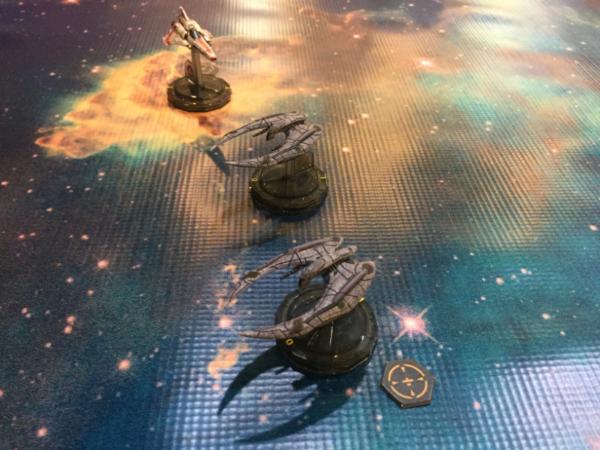I was finally able to get BSG-Starship Battles on the table today with forum member MarkyMark at Collectormania!
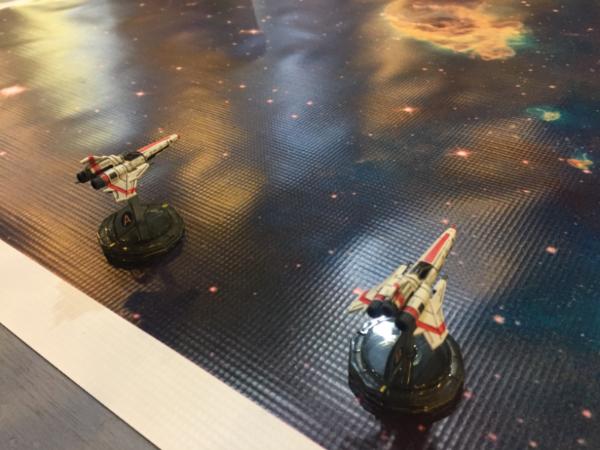
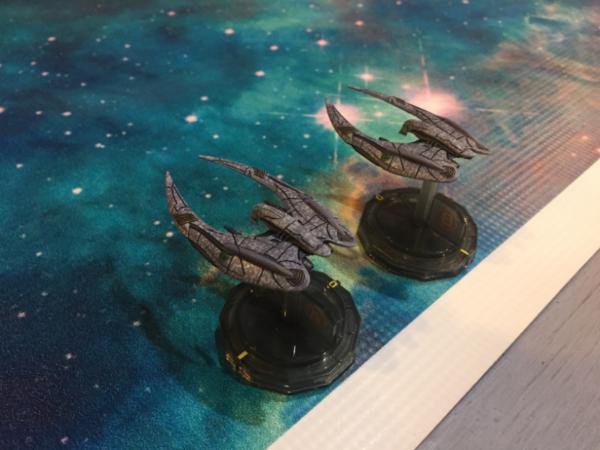
Mark played the dreaded Cylons, while I took the Colonials. We each had two starfighters apiece. We played a basic "slayer" game, each trying to be the first to kill all the enemy starfighters. No terrain, as we needed to get used to how the starfighters moved before we started throwing asteroids and planetoids in the way.
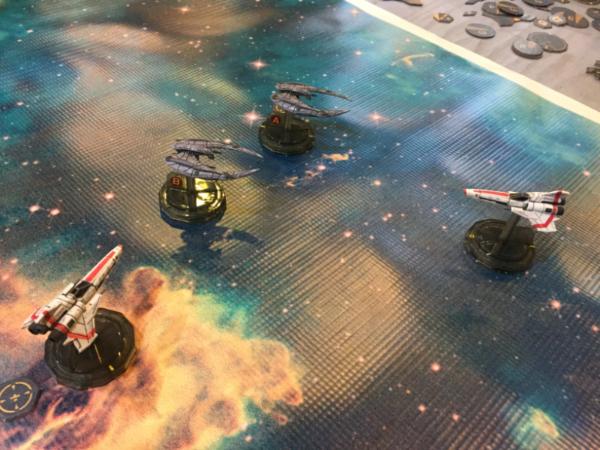
So, a basic overview of the turn phase:
1. Plan ship movement, which involves choosing the correct setting on the ship's control panel and choosing up to two maneuver cards.
2. First movement--each starfighter executes its first planned maneuver. This is simultaneous. Once each starfighter finishes its first planned maneuver, the player has the option of rotating the fighter (if planned on the control panel for that fighter).
3. Attack (optional, but any ships that attack now cannot attack later in the turn). Firing is simultaneous, so it isn't possible to obliterate an enemy starfighter before it shoots back at you (as far as I know).
4. Second movement--each starfighter executes its second planned maneuver (again simultaneous).
5. Attack (only if the fighter did not conduct an attack after the first maneuver) (again simultaneous).
It took us a few repetitions to get the rhythm of the turn, but by the end of the game I feel like we were getting the hang of it.
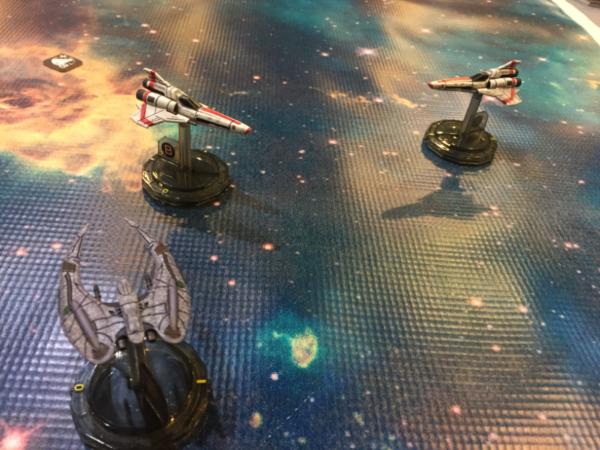
Basically, you can choose up to two maneuver cards to move each ship in each turn. If you choose two cards, one must be an overboost, which is generally either a straight line or a long 90-degree turn. You don't have to choose two cards; there is a "joker" (blank) card that you can play so that it looks as if you're planning two maneuver cards, thereby bluffing your opponent a bit.
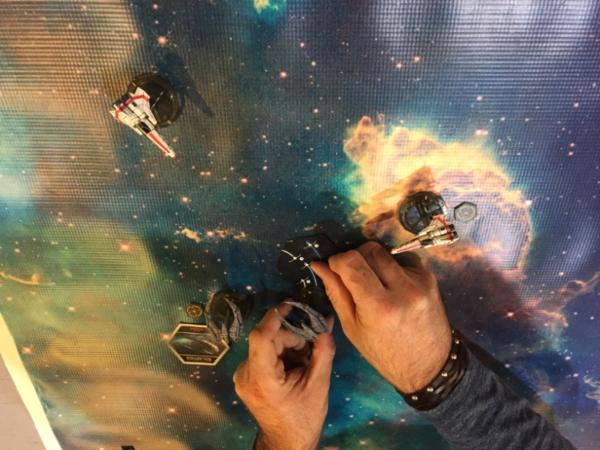
The maneuver cards are hexagonal and are meant to imitate the playing cards used by the characters in the show (you see this in the rebooted BSG, not sure if they were also in the original). The cards aren't very big, so even with two planned maneuvers the fighters aren't moving very far in each turn. To move, you line up the back of the maneuver card with the "0" mark on the front of the base (the "0" is always the direction the fighter is moving), then move the fighter's base to the end point of the maneuver. Most cards will have different "speeds" for each maneuver, and you use whichever speed that corresponds to your current kinetic energy and your chosen speed for this turn. There are some limitations to this which I won't go into here, but basically your fighter will end up in different places and orientations based on how fast you are moving going into the maneuver. (This is where the consoles for each ship come into play).
Then the fun starts...you get to rotate your ships! If you've seen the rebooted BSG series, you'll remember that both the Vipers and the Cylons could spin 360 degrees on their axis in order to fire.
In the picture below, a Viper and a Raider are passing each other and turned 90 degrees so they can both fire on each other. The starfighters are actually moving in the direction of the "0" on their base (the Viper is moving towards the top edge of the picture, and the Raider is moving towards the bottom edge):
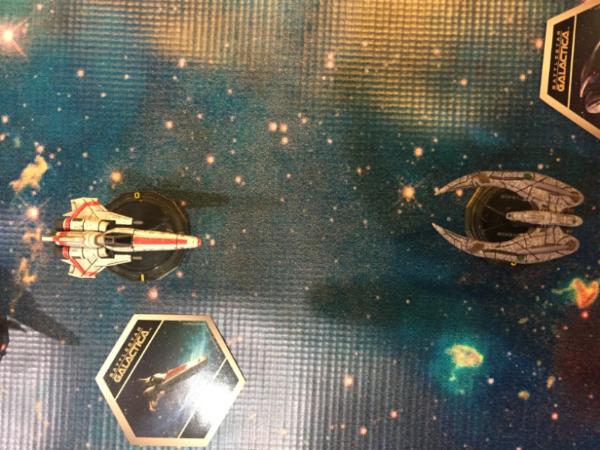
You can spin the ships 180 degrees in either direction in a turn. (Actually technically you could spin them up to 360 degrees in a turn, but there would be no point in doing that).
In order to fire on an enemy ship, it has to be in arc and in range. You can see the firing arc in the picture below (look at the Viper's base; it's the wedge shape under the starfighter's nose. The Viper is actually facing backwards in that picture, i.e. the nose is pointed in the opposite direction that the starfighter is moving).
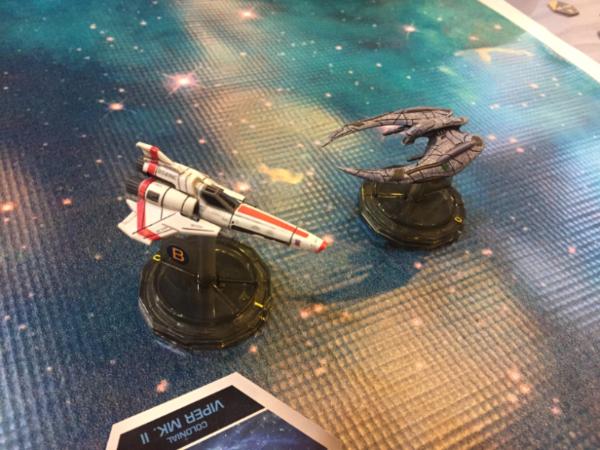
If you look at the Raider's firing arc, it has the Viper dead to rights! (Additionally, that Raider is facing almost 180 degrees away from it's direction of travel--look where the 0 is on the base). There are two range rulers in the starter set, and there is no difference in firing between the Viper Mk II and the Raider. Each starfighter has an attack value; for both fighters in the starter set, the attack value is 6. Range is measured from the center peg of the attacker to the closest point of the defender's base. There is a close, medium, and long range; close range gives +1 to the dice roll, and long range gives -1 to the dice roll. There are other modifiers that can be added on based on the attacker's speed and the defender's speed, but I won't go into that here. If you have a target in arc and range, you roll 2D6 and add the results together, looking to get at or above your starfighter's attack value (after factoring in the modifiers). For fighters with an attack value of 6, if you're shooting at a target in close range, you need a 5+; at long range, you'll need a 7+. If you score a hit, your opponent has to blindly pull a damage token (we had them in a dice bag).
Each starfighter has a structural value (14 for the Viper Mk II and 15 for the Raider). The damage tokens will have a number; when you've drawn enough to equal or exceed that value, the starfighter is destroyed. One of the neat things about this game is that, in addition to pulling blindly from the pool of damage tokens, you do not reveal the amount of damage to your opponent (unless there is a critical effect that requires you to give your opponent information). Some of the damage tokens are 0; the highest is 12. You pull one damage token per hit; if the token has a + sign next to the number, you have to draw another token. These are stacked by that starfighter's control console. So you *could* wax an enemy starfighter in one shot, if your opponent pulled the right (or wrong!) tokens. Conversely, your opponent could pull a few damage tokens that are 0, and you would be none the wiser!
If the starfighter attacks after the first maneuver, you put a marker next to it indicate it can't fire after the second maneuver. After the second maneuver, any starfighters that haven't attacked yet this turn can attack, if they have targets in arc and range.
Then the turn is over, and you go back to planning maneuvers for the next turn!
So, a few initial expressions:
-the starfighters are pre-painted and they are VERY nice!
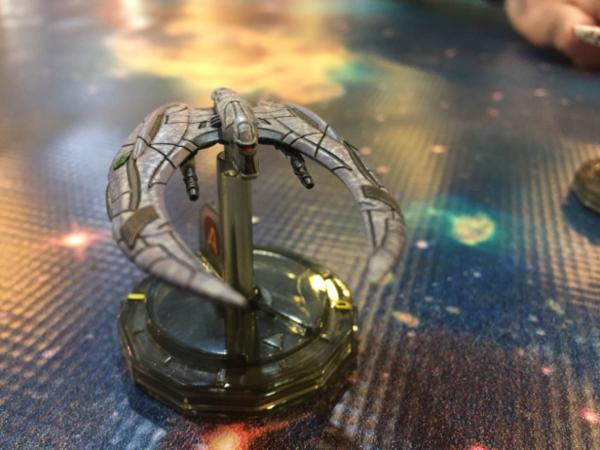
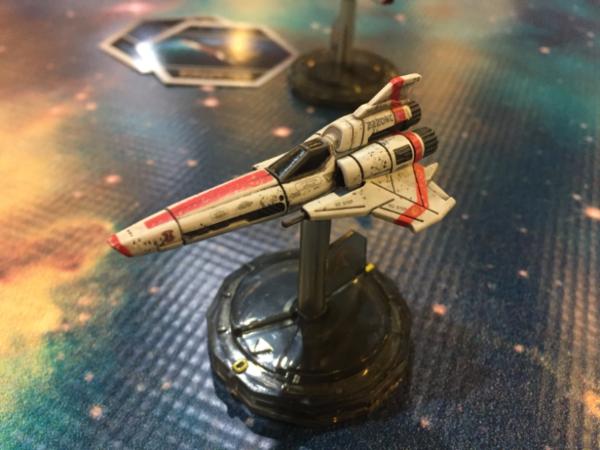
-the movement and shooting really captures the "feel" of BSG. I LOVE that I can send my Viper Mk II through an engagement completely backward, firing behind it as it goes through!
-movement and firing range are noticeably shorter than that other starfighter game set in a galaxy far, far away. But if you've never played that game, you wouldn't know the difference.
-executing maneuvers is just a bit fiddly; it's very easy to bump either the starfighter base or the maneuver cards when you are moving the fighters.
-there are a LOT of options for movement (21 different movement cards for each starfighter in the starter set), however these are necked down based on your speed and ability to maneuver. So you don't have to choose from all 21 cards every time you plan maneuvers, since not all of them will be available to you in every turn.
Overall--it's a fun game! The movement/maneuver system is probably what will take the most time to learn, however that is also what sets this game apart. Being able to rotate the ships is key, and the mechanic used to change direction while rotated is pretty smart (I didn't really cover that above--this review is running a little long already).
There were a few things we didn't get to try in this game, the biggest of which is the named pilots. The Colonials have Lee "Apollo" Adama, and the Cylons have a level 4 and level 5 AI. Each has it's own strengths and weaknesses, which will help with shooting and maneuvering.
Very much looking forward to getting this on the table again. Thanks for reading!
